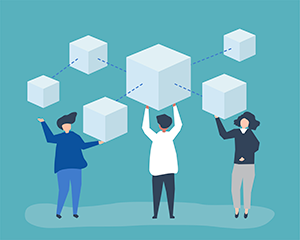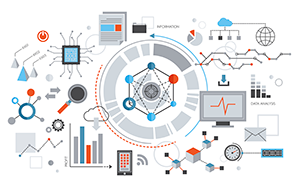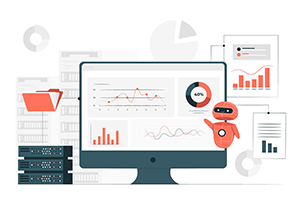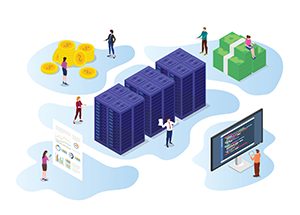Over the last two decades, the rapid pace of technological advancement has led to the widespread adoption of technologies that are changing how we live and work. Of all these technologies, big data analytics and blockchain have probably attracted the most attention from today’s business world. While big data provides valuable insights through analyzing raw unstructured data, blockchain technology offers a secure and transparent way to track transactions and assets within a business network.
Both blockchain and big data analytics have their independent uses, but it's only in the last couple of years that IT specialists have thought about combining them. Such a combination holds the promise of unlocking the full potential of these technologies through blockchain analytics, a new way for businesses to understand and utilize their data.
What is blockchain?
 Blockchain was introduced to the world in 2008 by publishing a white paper titled “Bitcoin: A Peer-to-Peer Electronic Cash System.” The paper aimed to solve the issue of double spending in financial transactions by eliminating the need for a third-party authority or central server. Blockchain was the answer to that issue.
Blockchain was introduced to the world in 2008 by publishing a white paper titled “Bitcoin: A Peer-to-Peer Electronic Cash System.” The paper aimed to solve the issue of double spending in financial transactions by eliminating the need for a third-party authority or central server. Blockchain was the answer to that issue.Developed as a decentralized digital ledger, blockchain records and verifies transactions across a network of computers. It achieves this through cryptography, which allows for secure, transparent, and tamper-proof transactions, which cannot be altered once the data is recorded. Each block in the chain contains a record of multiple transactions, and each block is linked to the block before it, creating a chain of blocks that cannot be broken. This creates a permanent, unchangeable record of all transactions on the network.
Since its development, blockchain has mainly been used by cryptocurrencies, of which Bitcoin was the first. But over the years, blockchain has also found uses in other areas, such as smart contracts, the Internet-of-Things (IoT), supply chain management, and digital voting.
The past decade, in particular, has seen a significant rise in the popularity and adoption of blockchain-based technologies. According to a recent report, the global blockchain technology market size was valued at $10.02 billion in 2022 and is expected to grow at a compound annual growth rate of 87.7 percent from 2023 to 2030. These growth rates suggest that this technology is here to stay and will significantly influence the future of business.
What is big data analytics?
 Big data technologies have been around since the dawn of the millennium and were developed to meet the computational challenges and opportunities of large datasets in the internet era. Adoption was slow at first, but as more open-source applications hit the market, the use of big data has snowballed to the point where almost every business is now data-driven.
Big data technologies have been around since the dawn of the millennium and were developed to meet the computational challenges and opportunities of large datasets in the internet era. Adoption was slow at first, but as more open-source applications hit the market, the use of big data has snowballed to the point where almost every business is now data-driven.At its heart, big data analytics is all about collecting enormous streams of data, which are then analyzed to uncover valuable insights, such as market trends, customer preferences, and other hidden patterns. These insights help organizations make informed business decisions. While this process -- known as data science-- can on the face of it seem pretty straightforward, it’s actually incredibly complex, involving vast volumes of structured and unstructured data that must be stored, classified, indexed, and secured.
Managing all this data has only gotten more difficult with time, especially when it comes to “dirty data,” e.g., inaccurate, incomplete, or inconsistent data. In addition, as data volumes grow, so does the need to secure that data against cyberattacks, which are on the rise and becoming more sophisticated with each passing year.
How blockchain can support data analytics and data science
 Blockchain is all about recording and validating data, whereas data science is about deriving business insights and predictions from data. By combining the two into blockchain analytics, organizations can enjoy a host of benefits. For instance, since blockchain can support any type of digital information, it can be used within the field of data science. This adds another layer to the data analytics process, which accomplishes two things:
Blockchain is all about recording and validating data, whereas data science is about deriving business insights and predictions from data. By combining the two into blockchain analytics, organizations can enjoy a host of benefits. For instance, since blockchain can support any type of digital information, it can be used within the field of data science. This adds another layer to the data analytics process, which accomplishes two things:First, it secures the data against cyberattacks, since the data is stored on a decentralized network that cannot be easily targeted. Second, it solves the issue of dirty data since the use of cryptography in the blockchain makes it impossible for any data to be manipulated. This allows for a high level of transparency and trust in the insights gained from blockchain analytics. Organizations can trust that the data they are analyzing is accurate and reliable, allowing the data to be put straight to use where it will give them a competitive edge in their industry.
Furthermore, by leveraging specialized analytics software and tools, companies can gain valuable insights into blockchain transactions. These tools allow for the extraction and organization of data from the blockchain, providing a deeper understanding of transaction patterns, network activity, and other vital metrics. In addition, organizations can incorporate machine learning algorithms into the analysis of blockchain data to reveal trends and anomalies that might otherwise have gone unnoticed.
When it finally comes time to make use of the data, visualization tools can ensure that any findings are presented clearly and understandably, so decision-makers can act on the insights gained from blockchain analytics.
Final thoughts
 In summary, combining big data analytics with blockchain technologies provides organizations with a more robust and efficient way to analyze and utilize their data, giving them a competitive edge in today's data-driven world. While both technologies have already been around for a while, it's only very recently that IT specialists have begun using them together.
In summary, combining big data analytics with blockchain technologies provides organizations with a more robust and efficient way to analyze and utilize their data, giving them a competitive edge in today's data-driven world. While both technologies have already been around for a while, it's only very recently that IT specialists have begun using them together.As each of them continues to evolve, their relationship will likely become increasingly mutually beneficial, leading to the discovery and development of more use cases in the future.


